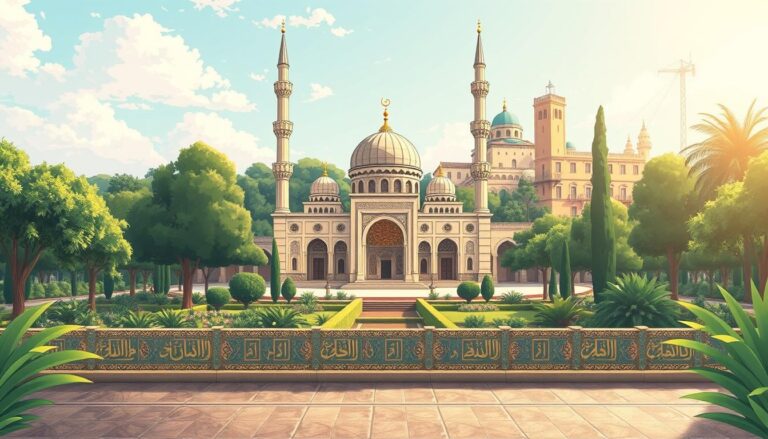Islam in Japan
Only 1 in every 500 people in Japan is a Muslim, yet the country’s Muslim population has more than doubled over the past decade, reaching an estimated 230,000 as of 2020. This rapid growth underscores the rising prominence of Islam within Japan’s increasingly diverse society. While the history of Islam’s presence in Japan is relatively brief compared to other parts of Asia, the religion’s footprint has expanded significantly in recent years, with the construction of new mosques and the increasing visibility of Islamic culture.
Key Takeaways
- Japan’s Muslim population has grown from around 1 in 1,000 people to 1 in 500 in the past decade.
- Approximately 95% of Muslims in Japan are immigrants, primarily from countries like Indonesia, India, Pakistan, and Bangladesh.
- The number of mosques in Japan has increased from 20 in the early 2000s to 133 as of April 2023.
- Tokyo is home to the largest Muslim community in Japan, with over 30,000 Muslims, while other major cities like Osaka, Nagoya, and Yokohama also have significant Muslim populations.
- The rise of halal tourism and social media have played a significant role in the growing visibility and acceptance of Islam in Japan.
Early Encounters: Muslim Traders and Diplomats in Japan
The earliest known Islamic presence in Japan can be traced back to the 9th century, when the Persian cartographer Ibn Khordadbeh mentioned Japan as the “lands of Waqwaq” in his writings. This suggests that Muslim traders had already established some form of early Islamic presence in Japan during this period, as part of the vibrant Silk Road connections between the East and West.
The first recorded Muslim diplomat to visit Japan was Sadr ud-Din, who was sent by Yuan China in 1275 to order the Japanese to submit to the Yuan emperor. Sadr ud-Din’s mission, however, ended in tragedy when he was beheaded by the Japanese authorities. Interestingly, a Buddhist monk criticized the executions of these foreign envoys, hinting at an early awareness and interaction between Japan and the Muslim world.
In the 13th century, a manuscript written by Persians from Quanzhou in China for a Japanese monk was also brought back to Japan, further highlighting the cultural and intellectual exchanges taking place between the two regions during this period.
“The earliest Muslim records of Japan can be found in the works of the Persian cartographer Ibn Khordadbeh, who mentioned Japan as the ‘lands of Waqwaq’ in the 9th century.”
Tatar and Ottoman Influence in the Meiji Era
In the late 19th century, the Meiji Era in Japan witnessed a significant influence from Tatar Muslims and the Ottoman Empire. Several hundred Tatar Muslim refugees from Central Asia and Russia were given asylum in Japan, settling in major cities and forming small communities. Through these interactions, some Japanese individuals, such as Kotaro Yamaoka, converted to Islam and even performed the Hajj pilgrimage, becoming the first Japanese Muslim converts.
Tatar Refugees and the First Japanese Converts
The presence of Tatar Muslims in Japan during this period had a notable impact. These refugees from Central Asia and Russia established themselves in various Japanese cities, creating small but vibrant Muslim communities. The connections between the Tatar Muslims and the local Japanese population led to the conversion of several individuals, including Kotaro Yamaoka, who became the first Japanese person to undertake the Hajj pilgrimage to Mecca.
The Ottoman Frigate Ertugrul and Japan’s Early Mosques
The Meiji Era also witnessed the influence of the Ottoman Empire in Japan. In 1890, the Ottoman Empire dispatched the naval vessel Ertugrul to Japan, but tragically, the ship was destroyed in a storm, leading to the establishment of the Kushimoto Turkish Memorial and Museum. This event marked a significant moment in the early history of Japan’s relationship with the Muslim world. Additionally, the first mosque in Japan, the Kobe Mosque, was built in 1935 with the support of the Turko-Tatar community, followed by the construction of the Tokyo Mosque in 1938, further solidifying the Islamic presence in the country.
“The Restoration of Japan in the Meiji Period from an Arab-Islamic Perspective” examines the Arab-Islamic scholarship of the Meiji Restoration era, recognizing Japan’s economic, social, and cultural progress during this transformative period.
Pan-Asian Nationalism and the Spread of Islam
In the late Meiji period, close relations were forged between Japanese military elites with an Asianist agenda and Muslims. This alliance sought to find a common cause with those suffering under colonial rule. Nationalistic Japanese groups like the Black Dragon Society (Kokuryūkai) actively supported the efforts of Muslim figures like Abdurreshid Ibrahim to spread Islam in Japan and build the first mosques.
The pan-Asian nationalism movement and its intersection with Islamic influence in Japan played a significant role during this era. A study on the pan-Islamic appeal had a range of 46-67 within Middle Eastern Studies, highlighting the potential synergy between these two ideological forces.
“The Khilafat Movement, detailing religious symbolism and political mobilization in India, was a notable subject of study during this period.”
The Islamic modernism in India and Pakistan from 1857 to 1964 was another area of scholarly interest, as was the politics of Muslim cultural reform in Central Asia. These developments showcased the growing Islam and Japanese nationalism connection on a broader, regional scale.
The interplay between pan-Asian nationalism and the spread of Islam in Japan during this era laid the foundation for a complex and evolving relationship between the two. As the political and cultural landscapes shifted, the influence of these movements continued to shape the trajectory of Islamic presence in Japan.
World War II and the Postwar Period
The impact of World War II and the postwar period on the Islamic community in Japan is not well documented, but the country’s relationship with Muslim communities continued to evolve during this time. The Tokyo Mosque, completed in 1938, remained an important center for the growing Muslim population in the following decades.
Japan’s Relationship with Muslim Communities
During the war years, Japan faced significant challenges due to resource scarcity, leading to concerns over overpopulation and reliance on international waters for food consumption. While Japan experienced a 12-fold increase in whale consumption between 1930 and 1938, the lack of evidence of prewar Japanese community interactions with ordinary Malays indicates that resource scarcity took precedence over social interactions in Southeast Asia.
In the postwar period, Japan marked 70 years since the end of World War II in 2015. Significant concerns exist in Okinawa over the relocation of the United States Marine Corps’ base within Camp Schwab, and former Hiroshima mayor Tadatoshi Akiba has emphasized the need for nuclear abolition as a survivor of a nuclear bombing. The number of living hibakusha (atomic bomb survivors) is decreasing, raising concerns over the next generation’s ability to overcome nuclear proliferation challenges.
Despite these historical events, the growing population of Muslims in Japan and the increasing public interest in the nature of religion following incidents involving Islamic extremists suggest that the relationship between Japan and its Muslim communities continues to evolve in the postwar era.
Islam in Japan
While Islam in Japan represents a small minority, the religion has established a presence in the country through the construction of mosques, the growth of Muslim communities, and the integration of Islamic practices and culture into Japanese society. According to recent estimates, the current state of Islam in Japan indicates a surge in the Muslim population, with almost 112,000 to 230,000 people having accepted the faith, making it one of the countries where the religion is growing rapidly.
The increase in the Muslim population in Japan can be attributed to several factors, including the influx of immigrants from countries like Iran, Pakistan, Indonesia, and Bangladesh, as well as the introduction of visa-free tourism for countries like Indonesia and Malaysia. Additionally, the adaptation of Japanese restaurants to cater to Muslim customers by offering halal food has contributed to the growing visibility and acceptance of Islamic practices in the country.
The current state of Islam in Japan also shows that about half of the permanent Muslim residents have established families in the country, indicating future growth with more second and third-generation Japanese Muslims. Furthermore, the Islamic practices in Japan have become more prominent, with the number of mosques throughout the country rising to approximately 113, a significant increase from the situation in the 1980s when encountering a Muslim community or mosque in Japan was unimaginable.
“Japan’s Muslim community doubled in just over a decade, with a 110% increase from 110,000 in 2010 to about 230,000 in 2022.”
Despite the growth of Islam in Japan, the religious switching rate among Japanese Muslims remains relatively low, with many adhering to the faith due to cultural and familial ties. This trend suggests that the future of Islam in Japan is likely to see the continued presence and integration of the religion in the country’s diversifying society.
Rising Muslim Population and Mosque Construction
Japan’s Muslim population has grown significantly in recent decades, from an estimated 10,000-20,000 a decade ago to around 230,000 as of 2020, or about 1 in 500 people in the country. This growth is driven by immigration, demographic shifts, and an increase in marriage-based conversions to Islam.
Demographic Shifts and Marriage-Based Conversions
The number of Muslims in Japan has roughly doubled over the past decade, with non-Japanese Muslims making up the majority at around 183,000. Many of these migrants come from Indonesia, Pakistan, and Bangladesh, while Arab Muslims account for approximately 6,000. The remaining 46,000 are Japanese Muslims.
Alongside the influx of Muslim immigrants, marriage-based conversions to Islam have also contributed to the growth of the Muslim population in Japan. As Japan’s population diversifies, the country is witnessing an increase in the number of mosques, from just 4 in the 1980s to 110 in recent times.
“The number of mosques in Japan had risen from four in the 1980s to 110 by recent times. This growth indicates an increased presence of the Islamic community in the country.”
Despite the growth, Muslims still make up a small proportion of Japan’s overall population of over 126 million, where Shinto and Buddhism are the primary religions. However, the rising Muslim population and mosque construction in Japan reflect the country’s evolving demographic landscape.
Tokyo Camii: A Symbol of Islamic Presence in Japan
The Tokyo Camii, a mosque in the Ottoman Turkish style, has become a prominent landmark and a symbol of the growing Islamic presence in Japan. Located just a 5-minute walk from the Yoyogi Uehara Station, this impressive structure can accommodate up to 2,000 people during the Eid festival, with its Prayer Hall, mezzanine (reserved for women’s prayer), veranda, and Multipurpose Hall.
The mosque’s history dates back to 1938, when it was originally built by the Turkish community who had emigrated from Kazan (Russia) after the October Revolution. However, the mosque was later demolished in 1986 due to structural damage, and a new building was initiated in 1998, completed in 2000.
The new Tokyo Camii is a testament to the architectural prowess of its builders, with approximately 70 Turkish craftsmen involved in the finishing touches. The architect drew inspiration from Ottoman architecture, and a significant amount of marble used in the construction was imported from Turkey, adding to the mosque’s grandeur and authenticity.
Educational Efforts and Fostering Understanding
The Tokyo Camii is not just a place of worship but also a hub for educational initiatives aimed at promoting understanding of Islam in Japan. Shimoyama Shigeru, the mosque’s public relations head, works tirelessly to educate visitors, particularly students, about Islamic practices and history, dispelling misconceptions and fostering greater appreciation for the religion.
Through these educational efforts, the Tokyo Camii stands as a beacon of interfaith dialogue and a symbol of the growing diversity within Japan’s society. As the country’s Muslim population continues to rise, the mosque’s role in promoting understanding and integration will become increasingly vital.
Challenges and Opportunities for Integration
As the Muslim population in Japan continues to grow, the community faces significant challenges in overcoming prejudice and discrimination. The aftermath of the 9/11 terrorist attacks has contributed to a climate of suspicion and mistrust towards Muslims in Japan, often fueled by limited understanding and misconceptions about the faith.
Despite these obstacles, Muslim leaders and advocates are working tirelessly to promote greater integration and acceptance of Islam within Japanese society. Figures like Shimoyama, a Japanese convert to Islam, are leading educational efforts to foster understanding and break down stereotypes, particularly among the younger generation.
Overcoming Prejudice and Discrimination
One of the primary challenges facing the Muslim community in Japan is the need to overcome deep-rooted prejudice and discrimination. Studies indicate that the Japanese government’s promotion of multiculturalism started in 2005, but the efforts towards meeting the needs of foreign residents, including Muslim migrants, have been primarily driven by self-help initiatives and limited institutional support.
- The increase in resident Muslims and their settlement in Japan beyond metropolitan areas is evidenced by the geographical spread of mosques and the diverse characteristics of the current Muslim population in terms of country of origin, nationality, ethnic identity, occupation, and place of residence.
- The Muslim migrant community in Japan is diverse, coming from various countries such as Southeast Asia, the Middle East, and Africa, resulting in cultural exchange within the community.
- Tourism in Japan has contributed to the familiarization of the Japanese with Islam and has created spaces for acceptance and adaptability.
By fostering greater understanding and dialogue, Muslim leaders in Japan are working to break down the barriers of prejudice and discrimination, paving the way for a more inclusive and harmonious society.
“The globalization of tertiary education has led to a growth in Muslim students across Japan, with some deciding to work in the country after graduation, contributing to the overall diversity of the Muslim population in Japan.”
As the number of mosques and Muslim residents continues to increase, the opportunities for integration and understanding also grow. The future of Islamic integration in Japan will depend on the collective efforts of the Muslim community, the Japanese government, and the wider society to embrace diversity and promote mutual respect.
The Future of Islam in Japan’s Diversifying Society
As the global influence of Islam continues to grow, with the Asia-Pacific region now home to more Muslims than the Middle East, the role of places like Tokyo Camii as a center for the faith in Asia is expected to become increasingly important. With a rising Muslim population and greater interest from younger generations, the future of Islam in Japan’s diversifying society holds both challenges and opportunities for integration and understanding.
According to recent statistics, the estimated Muslim population in Japan is around 100,000, out of a total population of about 26 million people, positioning Muslims as a minority within the country. In contrast, some European cities have Muslim populations exceeding 100,000, showcasing a significant difference in Muslim demographic distribution compared to Japan.
Most Muslims in Japan are first-generation immigrants, predominantly from countries like Indonesia, Pakistan, and Turkey. The Muslim community in Japan consists mostly of blue-collar workers, with a minority engaged in businesses like used car sales. Efforts are being made to establish prayer spaces (Mussalahs) in various public places to accommodate Muslim worshipers, and the desire for Halal food has seen a gradual increase in availability, although finding good Halal restaurants remains challenging.
The future of Islam in Japan’s diversifying society presents both challenges and opportunities. Japanese culture presents challenges for Muslims in terms of societal integration, understanding religious practices, and dietary requirements. However, initiatives to create educational content about Islam through mediums like manga (comic books) are being explored to better engage with the Japanese population and introduce Islamic teachings effectively.
As the number of foreign professionals in Japan continues to rise, the influence of the Muslim community is expected to grow. The number of Indonesian nationals holding specified professional working visas in Japan increased from 1,556 in 2016 to 5,411 by mid-2022, with Indonesia being among the top 10 countries for the most populous foreign nationals in Japan. This influx of skilled Muslim workers presents opportunities for further integration and understanding of the faith within Japan’s diversifying society.
“The future of Islam in Japan’s diversifying society holds both challenges and opportunities for integration and understanding.”
Conclusion
The history of Islam in Japan is a complex and evolving story, with the religion’s presence in the country marked by both isolated encounters and periods of growing influence. From the early diplomatic missions and the arrival of Tatar and Ottoman refugees to the current rise in the Muslim population and the construction of mosques, Islam has established a place within Japanese society, even as it continues to face challenges in integration and overcoming prejudice.
As Japan becomes an increasingly diverse nation, the future of Islam in the country holds both opportunities and obstacles. Efforts to foster understanding and promote acceptance will play a crucial role in shaping the relationship between the Muslim community and their Japanese neighbors. The summary of key points highlights the significant milestones and demographic shifts that have defined the journey of Islam in Japan, underscoring the dynamic and complex nature of this cultural exchange.
While the road ahead may present its own set of challenges, the resilience and adaptability demonstrated by the Muslim community in Japan suggest a promising future. As the country continues to evolve, the integration and acceptance of diverse faiths and cultures will be essential in crafting a more inclusive and harmonious society.
Source Links
- Islam in Japan
- It Begins with Knowing: Ending Discrimination Against Muslims in Japan
- Islam in Japan: An In-Depth Look
- Blog #7 “Japanese who met Islam in the last days of Tokugawa shogunate” | イスラーム信頼学
- Celebrating 130 Years of Islam in Japan | YOMOYAMA
- Islam in Japan
- Muslim Activist Encounters in Meiji Japan – MERIP
- Japan’s Muslims
- Pan-Islamism and Nationalism (Nineteenth and Twentieth Centuries) (Chapter 4) – Islam and Asia
- No title found
- Islam and the Axis Powers in World War II: Germany and Japan’s treatment of the Muslim World from 1931 to 1945 — History is Now Magazine, Podcasts, Blog and Books | Modern International and American history
- The 70th Anniversary of the End of the World War II / How Japanese People Approach Religion | 公益財団法人フォーリン・プレスセンター(FPCJ)
- Islam and Muslims in “non-religious” Japan: caught in between prejudice against Islam and performative tolerance | International Journal of Asian Studies | Cambridge Core
- Why Islam Is The Fastest-Growing Religion In Japan
- The Remarkable Rise of Islam in Japan! – S2Jnews
- History of Islam in Japan
- Ever growing Muslim community in the world and Japan
- How a growing number of Muslims are making Japan their home
- Tokyo Camii: An Islamic Gem Admist the Bustling Rhythm of Japan’s Capital — shaopeng.blog
- Islam in Japan and It’s Origins | Halal Food in Japan
- The visibility of Islam in Japan | Routed Magazine
- To Bury or Not to Bury: Muslim Migrants and the Politics of Funerary Rights in Contemporary Japan – The Asia-Pacific Journal: Japan Focus
- muslim — Shizuoka Japan Is Home To A 700-Strong Muslim Community — Bahath | Redefining Muslim Media
- Promoting Diversity, Introducing Islam: Muslim Indonesian Professionals in Contemporary Corporate Japan – The Asia-Pacific Journal: Japan Focus
- Perceptions of Islam and Muslims in Contemporary Japan – New Voices in Japanese Studies
- S1479591421000012jra 81..97
- The number of Muslims in Japan is growing fast







